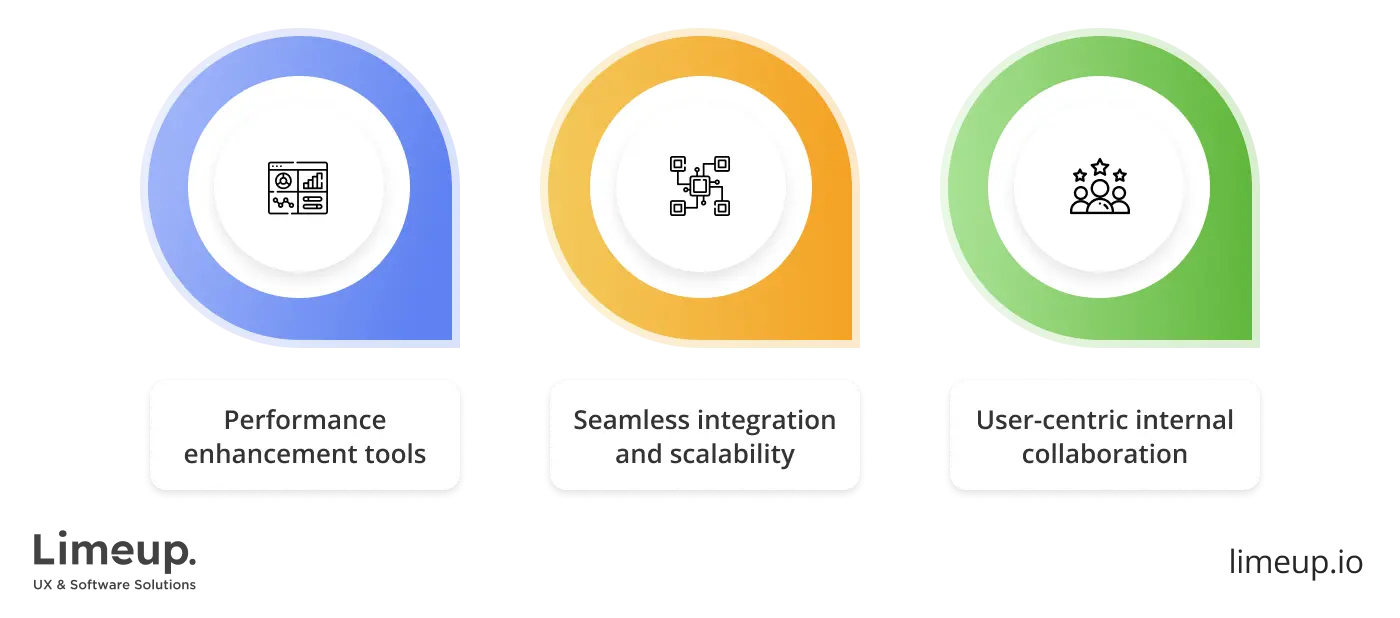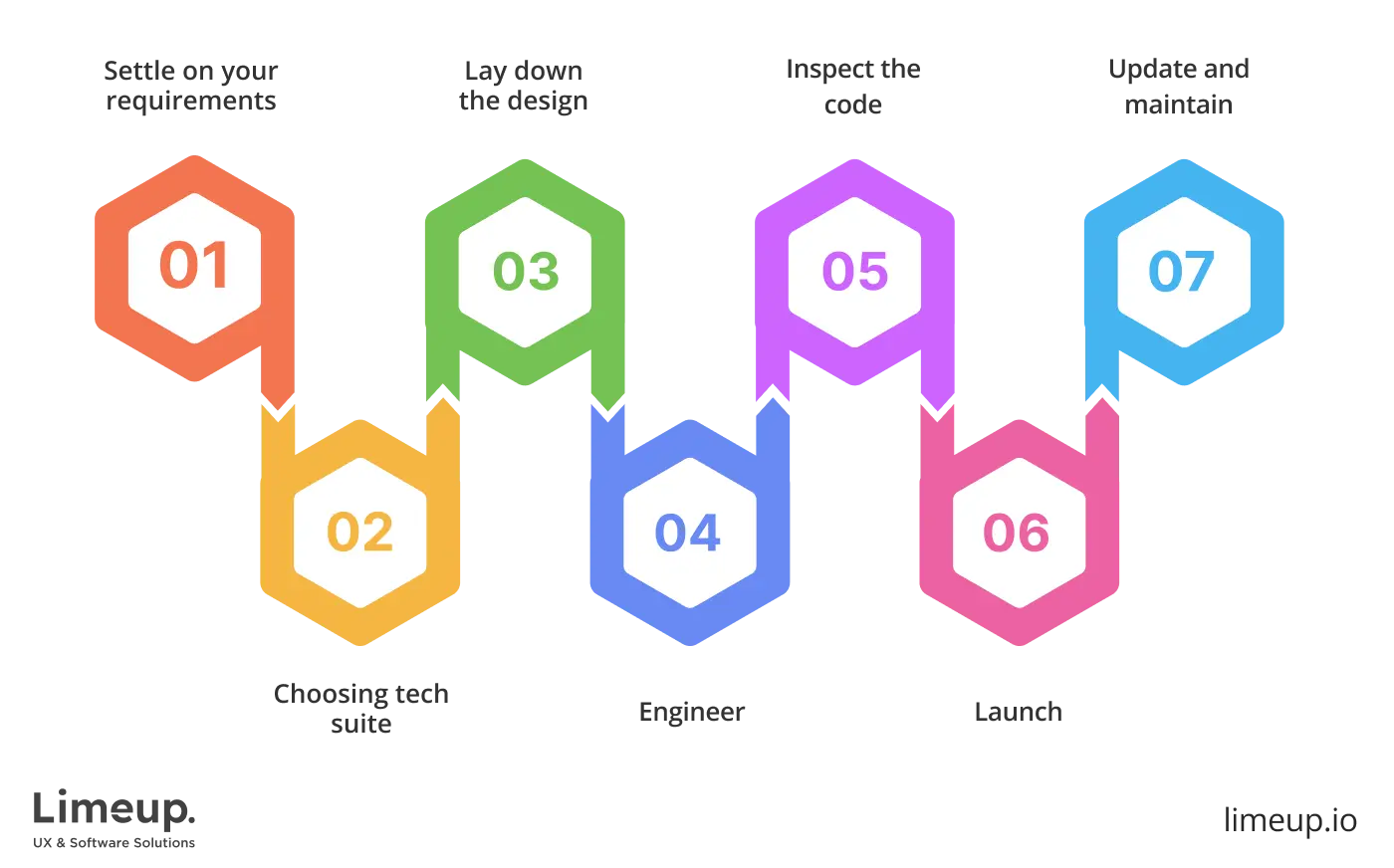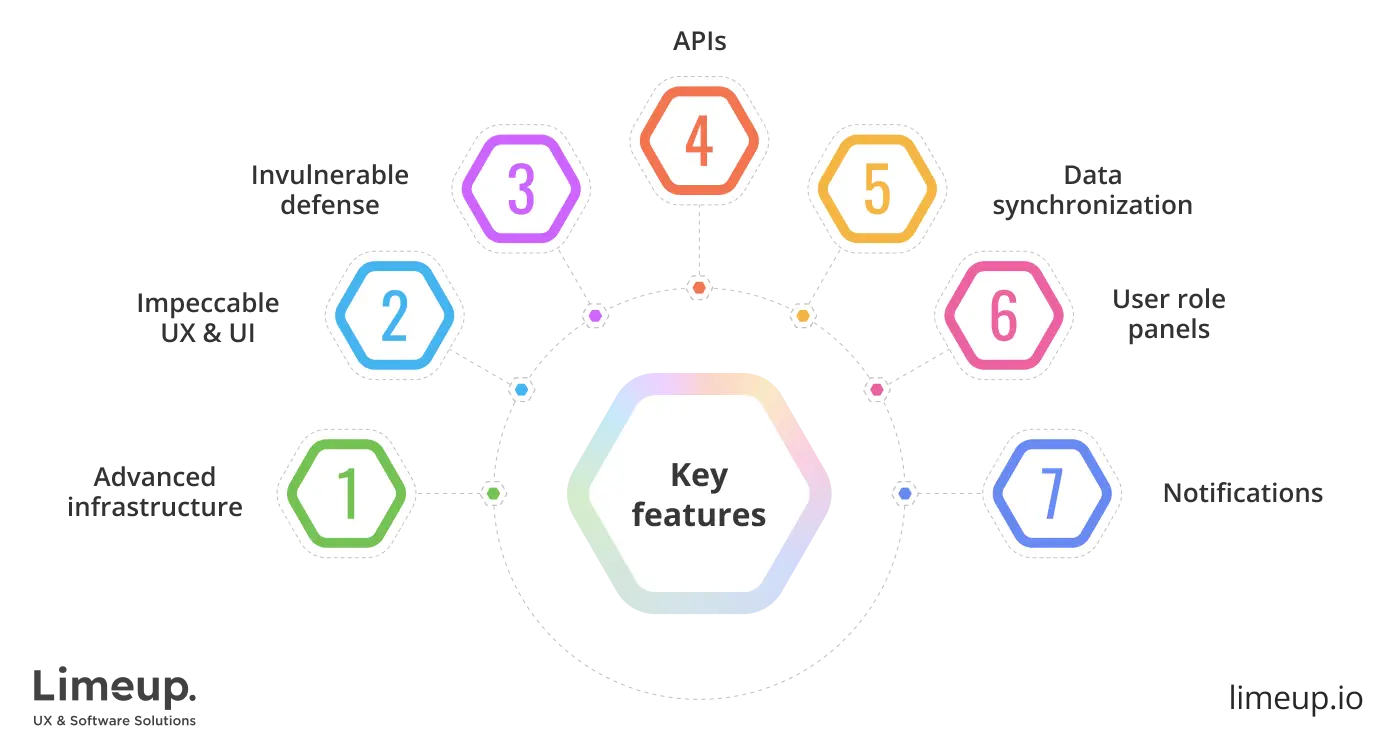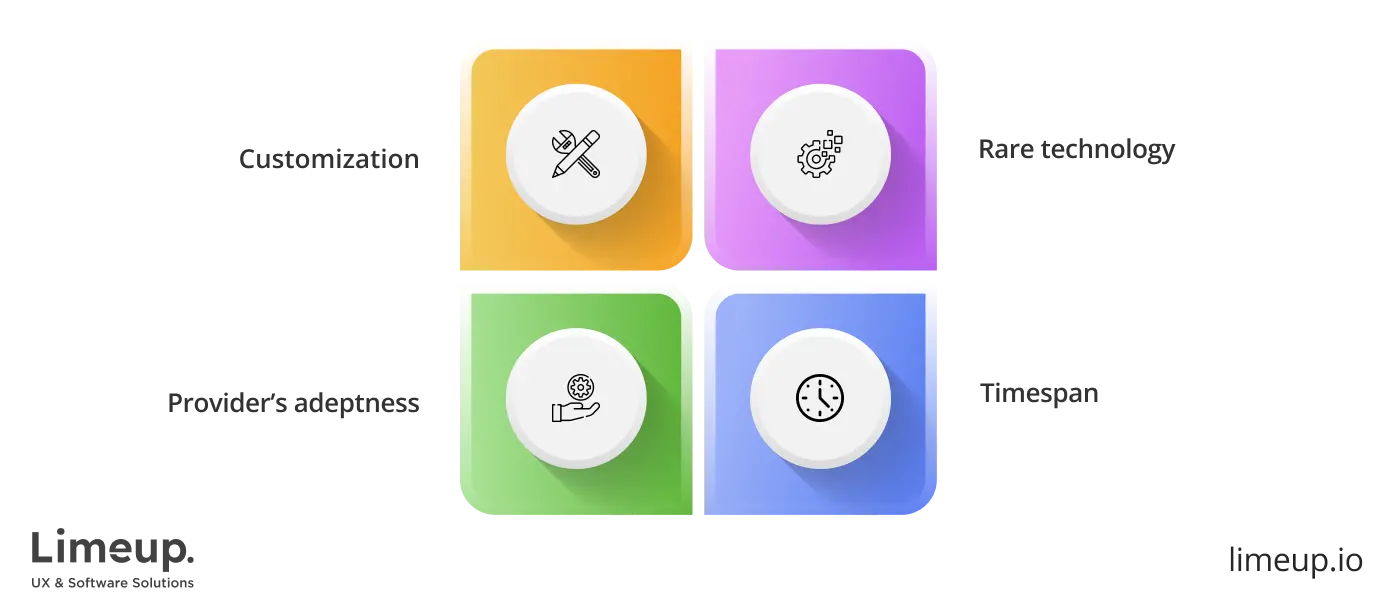Enterprise Application Development: Thorough Review

Enterprise mobile app development resolves multiple pain points of corporations, effectuating data sharing, centralizing all business workflows within one utility, and eliminating misunderstandings between all departments of your organization. In this summary, we are going to explore the most essential facets of engineering systems that help redefine inner processes.
Concerning building enterprise applications, we will touch on points such as their definition and the core features. We will walk you through the entire construction procedure, from laying down objectives to maintenance. You’ll find the details about the tech stack required to project such ventures for enterprises and discover pricing briefs and influencing factors.
Tap into reading about enterprise application development to learn how mobile app development services can advance the operations of your company. In the end, you’ll get a piece of advice on selecting a reliable vendor who will help you turn your challenges into opportunities.
What is an enterprise application?
nterprise utilities are systems that allow businesses to elevate their efficiency and enhance the quality of their services for clients. Such programs can be targeted at inner processes only (for example, they help administer employees or monitor supplies in inventory), or they can also incorporate features that make it possible to deal with outer operations (consumer support and so on).
Such programs can be connected to the Internet of Things to collect data from devices and receive analytics, which empowers firms to make informed decisions regarding fostering innovations or come in the form of databases with buyers’ data. They can be tailored based on an organization’s unique needs.
Types of corporate applications
There are several popular kinds of programs entities aim to obtain. Get acquainted with the variations of tech innovations and their benefits:

- Customer relationship management. Their primary purpose is to store customer records, facilitate personalized offers and help track engagement with people. They make it much easier to provide buyers with customized services, identify the churn rate and keep it under control.
- Finance programs. These digital resources automate invoicing and auditing, connect entities to banking institutions and simplify tax monitoring. Implementing them in your operations will significantly decrease the probability of human errors in reporting and accounts.
- Supply chain administration. It is a valuable output of mobile enterprise app development that enables completing the full purchasing flow from beginning to end, establishes connections between all involved parties and reduces the possibility of misalignments.
- Project management. Following demands becomes easier because this platform keeps track of deadlines, fosters collaborations and brings together all the facets of a venture. They can be customized, so workers set them according to their preferences. Such examples as Wrike and Jira also have in-built reporting capabilities.
- Resource planning. This type of portal merges all operations within one interface and advances forecasting. Taking into account your company’s demands, it can contain all the previously mentioned sets of features, incorporating financial management, supply chain, etc. They make a world of difference, driving revenue and reducing manual work.
- Human resources. Employing new workers and nurturing an effective workplace becomes simpler with enterprise app development services that level up recruitment and simplify interactions with employees. For instance, controlling your team members’ attendance, training and absences is a complete turnaround in comparison to traditional ways of administration.
- Business Intelligence. Adopting these instruments, corporations get access to data-driven findings that empower decision-making. These digital assistants accumulate revelations from multiple sources, leaving no stone unturned regarding including key takeaways. With the help of AI, market leaders predict changes and react on time.
- Marketing. They are designed to allocate leads, evaluate and effectuate sales, and monitor significant metrics. Taking advantage of such platforms will streamline your promotional efforts, give you informed analytics and make tracking a campaign’s success more accurate and strategically insightful.
What is enterprise application development?
Creating a productivity portal corresponds to building software that perfectly pertains to business expectations. The main task of this procedure is in constructing tools to boost an entity’s performance.
Programmer companies push boundaries to provide seamless utilities with all the necessary functions and potential for expansion and integration. They concentrate on engineering outputs that can handle massive amounts of real-time data by exploring every scrawny to deliver well-tuned workarounds that perfectly suit purposes and redefine the way a firm operates.

As the main difference between usual and enterprise app development is the target audience, the main focus of tech enablers is not to attract potential buyers and improve the level of loyalty but to set comfortable collaborative conditions. Instead of investigating the market to find the observations that will help win the hearts of consumers, technology catalysts put their effort into embedding complex ideas into simple navigation to secure logic and intuitiveness.
Forming productivity-boosting tech advancements is a process that consists of at least seven steps. Coders refine the plan of the undertaking, select technologies needed to attend to each part of a carry-out, craft responsive designs to ease employee engagement with the interface, stick everything together with APIs, add protecting layers and test.
It allows firms to polish their framework by adding structure to complex tasks and breaking them into smaller, manageable assignments. Apart from that, mobile systems increase the level of innovation availability.
Now, we invite you to explore the course of action closer.
How to develop an enterprise application?
Coding a corporate solution can take from 3 months to 12 or even more, depending on the complexity of the initiative. However, one thing is common across all the variations of utilities — their project lifecycle. Digital solutions, especially scalable ones, require sticking to a well-thought-out procedure, with which you can be acquainted in the following passages.

Find out what it takes to craft a bespoke digital instrument from the ground up to the launch:
Step 1. Settle on your requirements
Determining the purposes, goals and desirable results is the point from which the custom enterprise app development sets off. During this stage, you summarize the functionality and specify the milestones you want to reach, such as automating monotonous tasks, reducing repetitive assignments and paperwork, advancing communication between different departments and fueling business growth or altogether.
In addition to the technical aspects of custom app development, you discuss administrative facets, including timeline, budget limitations and then seal the deal by signing a contract.
Step 2. Choosing tech suite
With the defined criteria, innovative troubleshooters approach planning. First of all, they decide on programming languages they need to visualize data and automate business activities. As such, an initiative is multilayered, many facets of custom enterprise mobile app development are taken care of: the client and server panels, protection, internal connections, data entry and code evaluation.
Step 3. Lay down the design
A studio begins the interface building. They thoroughly study user behavior and map the journey to ensure seamless interactions and consistency. Designers draft visuals for every device — iOS, Android, PC, preparing layouts for each employee based on their roles and crafting reusable components, which can be utilized in the future.
With the invention of making the entire workflow clear, from core essentials to error handling, they create messages that help users deal with uncertainties.
Step 4. Engineer
This stage of programming is the most demanding. An enterprise application developer writes codes to glue all the elements together: databases, security mechanisms, design and external parties. The starting point is implementing responsive and user-friendly visuals. After that, the flow progresses to the back-end facet.
When the client and server sides are connected, system architects integrate protection methods to secure role-based access, authentication and data encryption. The code also undergoes testing during construction to ensure the right performance of particulars.
Step 5. Inspect the code
Before the outputs reach the deployment stage, they are attentively and thoroughly checked by providers of enterprise mobile app development services. The examination embraces multiple assessments: testing of units to evaluate each component separately, screening of integration to be sure of all the external modules’ perfect performance, and reviewing functions to ascertain that no errors appear.
The list of necessary actions is long, incorporating evaluation of security, regression and compatibility. It is so encompassing that after this checking, the final workarounds become fine-tuned, corresponding to all requirements and user expectations.
Step 6. Launch
As soon as the app is ready, it enters its release point, which lies in moving from the engineering to its working environment in order to make the utility available to the target audience. Such applications are not published on the App Store if they are not carried out for external purposes as well. Such deliverables with private access are distributed on Microsoft Intune, Jamf, or IBM MaaS360.
The variations aren’t limited to the aforementioned means. However, when vendors build an enterprise app, they additionally test it before disclosing it.
Step 7. Update and maintain
After coming to the closing phase, the program can be used to track resources if it is an ERP system. It allows personalizing promotional attempts when it is a CRM portal and enhances producing insights if your goal is to construct a Business Intelligence tool. No matter the kind, all deliveries need to receive regular updates and checks.
The technological landscape changes, and staying on top of things is crucial. Professional maintenance helps avoid downtimes and leaks of critical figures.
What are the key features in enterprise mobile app development?
The type of a corporate application is not significant when it comes to the core characteristics, most of them have the attributes we described, whether it is a marketing tool or HR. We deliberated on the set of components a productivity-driving utility must have:

Advanced infrastructure. A system whose purpose is to automate routine tasks of the entire organization has impeccable architecture, programmed in a way that it can be modified effortlessly in accordance with the expanding expectations of businesses. It can handle numerous requests without slowing down and manage data in no time, which is vital in fast decision-making.
Impeccable user interface and experience. An inner digital supply can go without a carefully planned panel for target audiences to avoid confusion and secure fast learning. When tech enablers conduct app development for enterprise, they thoroughly test the navigation to make it intuitive in order to facilitate a workable instrument and reduce the time of training.
Invulnerable defense. There are several concerns regarding protection that must be considered. First, it has to comply with regulatory requirements (GDPR, ISO). Second, data provided by customers and sensitive business information must be secured. Third, the safeguard should be designed in such a way that will align well with the growth of scalability.
APIs. Attaching databases and embedding functions like payment gateways in enterprise apps development is done by way of utilizing various application programming interfaces. The linkage between different elements of one utility is powered by them as well. Namely, when information connects inventory with other departments or Amazon resources, APIs stand behind it.
Data synchronization. Instant updates in business-related questions are one of the most important attributes. For example, if your firm has a new lead, all the departments involved will immediately get necessary details to turn a potential client into a regular buyer (their contact becomes available for managers who work with CRM). These enterprise app development solutions significantly level the communication between members of the collective.
User role panels. Most corporate systems assign access to certain activities based on the role of a worker. As an illustration, an executive can see figures of any scale of importance within the workaround, while a middle-level manager is able to edit and manage only those parts they are responsible for, being unaware of what is happening in the other divisions. Such an approach boosts safety since the most sensitive records remain hidden.
Notifications. Alerts, updates, and messages are part of the understandable sign language that a person can easily grasp and react to. In developing enterprise applications, tech savants tie certain sounds to operations such as validation, system errors, etc. When an administrator gets a new task, the program sends a notification, ensuring the worker receives updates.
Additionally, based on your special requirements, programmers can add reporting and analytics fused with AI that help spot weaknesses and create better strategies that will help you improve organization of work. They also leverage search filters if your team needs to look for information about the previous project or to check the client’s data. A layer of personalization gives workers the ability to optimize their online workspace.
How much does mobile app development for enterprise cost?
Estimates without direct consultations with application development companies in the UK won’t go further than guesses since your goals may be within the basic delivery package or can greatly exceed an average project. However, we outlined the outlays for every key attribute to give you an understanding of possible scenarios, taking into account our experience and the situation on the market.
The figures in the following table are approximate, and they can vary based on various factors we will explain further:
| A feature | Expenses (per function) |
| Role-based access | $5,000 – $10,000 |
| Dashboards | $10,000 – $20,000 |
| Security measurements | $10,000 – $25,000 |
| APIs integration | $5,000 – $25,000 |
| Notifications | $3,000 – $8,000 |
| Reports and analytics | $10,000 – $20,000 |
| ML/AI | $25,000 – $100,000 |
| Cloud storage | $5,000 – $15,000 |
The following determinants impact budget planning:

- Customization. Specialists proficient at enterprise applications development have refined their skills in delivering certain kinds of characteristics, like integrating particular third parties or writing code for safeguarding mechanisms. Looking for assistance to create one-of-a-kind deliverables tailored to your needs raises the numbers in expenditure plans.
- Provider’s adeptness. The rates of programmers are formed based on their expertise. Beginners price their work between $30 and $60. Middle specialists charge from $50 to $100 for their assistance. Seniors have the most expensive tags — $100 – $150 per hour.
- Rare technology. Blockchain enhancements upgrading protection or Artificial Intelligence opportunities fueling analytics — are popular enterprise application development services. Yet, they are not common for every agency, and prices significantly extend the classic offerings like Python or Java engineering.
- Timespan. In a vast number of cases, providers adopt hourly rates as their preferred payment method. When your objectives are well-defined and don’t change over the project, it is possible to stay within the allocation. However, if numerous adjustments are supplied, it will eventually lead to the expansion of deadlines and rising costs.
We can name a few more influencing factors, such as location, economics, and recognition of vendors.
What is the tech stack for enterprise app development?
A well-performing corporate tool is a multi-layered structure. To create it, programmers utilize an abundance of resources. Below, you will find the list of frameworks and instruments you need to mind when you hire app design experts:

— Front-end
A corporate utility has to simplify operations for employees and accelerate processes, which is why its interface should be as intuitive as possible, so it won’t take too long to grasp it. To build enterprise applications’ client sides, a coder needs to know the key technologies, including HTML5, JavaScript and CSS. Alongside the core mighties, they need to know about means for creating dynamic navigation and UI components — React, Angular and Vue.js.
Scalable ventures often require TypeScript, which is perfect for ensuring data safety, easy maintenance and storage.
— Back-end
Integrating third-party connections, constructing infrastructure, embedding authentication and ensuring logic are related to server-side programming. It encompasses an abundance of necessary skills, starting with Java and Python languages and heading to Spring Boot, .NET Core, Express and Node.js.
Speaking of the APIs in enterprise mobile apps development, the coders must know the fundamentals of gRPC protocol and tools, such as GraphQL and JWT, which improve linkages and make the data entry safer.
— Databases
The importance of data storage in corporate apps is undeniable. Thus, it is not an ordinary question. The information must be processed according to the firm’s objectives and be extensible, manageable and protected to prevent the leaks of sensitive business records.
There are several variations of databases, and the suppliers of innovative solutions have to be proficient in dealing with at least two or three. SQL databases (PostgreSQL, Microsoft SQL Service, Oracle) are usually adopted due to their lightweight and good scalability. When the structure of data is not paramount, there are document stores (MongoDB), graph (Neo4j), or key values (Redis).
— Cloud computing
If you look to enterprise app development services to create a system that collects tons of information (from sensors and chips), then cloud resources are your saviors. Oracle, IBM Cloud, Amazon Web Services, or Microsoft Azure will allow you to store and manage your data and scale it if needed. Such solutions’ effectiveness lies in their affordability and accessibility.
There are various advancements in security, databases, platforms and infrastructure with proven efficiency.
— Mobile engineering
A high-end utility for corporations is typically not restricted to only PC versions. Employees can access them from tablets, Android and iOS-powered smartphones. This means that the engineer you are going to partner with must possess comprehensive knowledge of instruments required to lay the foundation for a well-running mobile application.
Being targeted at exceptional performance, you’ll need to cooperate with vendors who have polished their proficiency in native programming, covering such aspects as Swift, Objective-C, and Xcode for iOS and Kotlin and Java for Android. Prioritizing a fast launch, you’ll need the assistance of professionals who have mastered cross-platform frameworks, including Flutter, React Native and Xamarin.
How to select a provider for building enterprise applications?
When you look for enterprise app development companies, follow the simple roadmap we summarized below. This practical advice will help you meet your target accurately and find tech savants who are able to realize your idea in the best way possible:

- Clarify your goals. When you settle on functionalities, results, or such criteria as timeline, budget and region, it will help you cross out those suppliers who don’t fit your demands. Otherwise, there is a risk of contacting suppliers who are not capable of meeting your targets, which will challenge you to repeat the sequence of searches once again.
- Opt for several providers. Building a large-scale business utility requires well-versed programmers to ensure customization, scalability, security and integration. This short list is only the tip of the iceberg, that’s why the app developers for hire you will join forces with must understand the know-how, covering the tech suite we mentioned above and even exceeding it.
Locating studios capable of boosting your entity’s performance, managing risks and providing cost-effective deliverables is an easy walk if you turn to numerous directories of vendors, hand-picked in accordance with their specialization, positive track record and praising
- Assess portfolios. Utilize reviews of contenders or talk to contacts who’ve worked with’ eams. It is a great source of information that will quickly demonstrate their design abilities, transparency and technical prowess to you. Without any case studies or just a small card with very limited descriptive and illustrative materials, it will be difficult to tell if they are accomplished enough.
- Make sure their tech stack matches your requirements. A scalable infrastructure, strong security, out-of-ordinary designs and AI-fuzed functionalities can be sourced from one tech troubleshooter. They must have polished at least those enterprise web app development skills we have mentioned in the previous segment.
- Inspect their reputation. In most cases, a simple Google request will give you enough records to check their credibility. Do they have any testimonials on comment aggregators? What rates did their clients give them? Is there any negative feedback? If their marks are low, what facet of work they can’t handle — the quality of work or deadline compliance?
- Test communication. Concretize some ideas about their completed works you could have while screening, ask more about terms of custom enterprise application development, and shed light on the flow of completion. Mutual understanding and common culture nurtures beneficial collaborations.
Why choose Limeup to build your next enterprise app?
Now, you can see that completing a high-performing utility is not easy. First, you need to clarify your objectives, from matters like the goals of your venture to pricing and timespan details. Second, check out where to find a vendor who has a refined approach to constructing seamless, insight and revenue-driving utilities. Third, there is an entire list of competencies a supplier must have. And we can’t say that this short enumeration covers all concerns.
Following all these stages, you need to conduct multiple research into suppliers, legal aspects, trends of the type of app you want to order and benefits and challenges to possess an in-depth understanding of the nuances of such an initiative. However, you have an opportunity to simplify those quests by contacting Limeup.
Our enterprise app developers have overcome multiple digital challenges so far, covering the needs of businesses of all sizes from different industries. We explore every avenue to deliver exceptional programs that will help you optimize operations, from enhancing communication to automating routine and monotonous work. Give your employees the space to focus on their core responsibilities while a cutting-edge application takes care of the rest.

